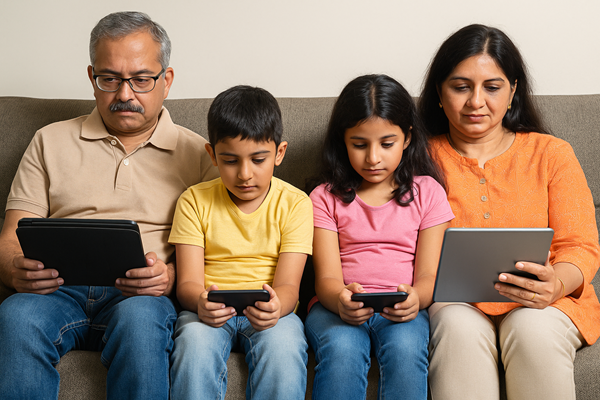.png)
Sarci-Sense: The ‘Hum Do, Hamare Do’ Mantra of the Middle‑Aged
In countless Indian middle‑aged homes, the old fight over the TV remote has quietly ended, replaced by two screens, two feeds, and a silence that feels like peace. But is there peace?


Dr. Srinath Sridharan is a Corporate Advisor & Independent Director on Corporate Boards. He is the author of ‘Family and Dhanda’.
August 3, 2025 at 8:43 AM IST
Once upon a time, and it isn’t so long ago as nostalgia would like to claim, the living room television was the shared hearth of middle-class Indian homes. Its soft flicker drew families together after dinner, when the day’s worries could be folded away for a while. Grandparents, parents and children, and later, husband and wife alone, might still bicker over what to watch, but there was something democratic, even intimate, in that nightly negotiation.
The great paradox of progress, of course, is that it grants precisely what we once fought over, and quietly takes away what made the fight worth it. Today, in countless homes, couples in their forties and above, sit under the same roof yet watch entirely different worlds unfold.
He takes the news debate to the bedroom TV; she keeps the tablet propped beside her dinner plate, absorbed in a Korean drama or a travel vlog promising gentler destinations than tomorrow’s commute. They are together, and yet not.
At first glance, it seems harmless. Aren’t these small comforts what midlife has earned us? Why must a couple who already share a mortgage, a child’s college anxiety and an occasional blood pressure scare also share a television screen? And yet, if one listens closely, the silence in these homes is no longer companionable. It is an agreement not to engage and a quiet cold war brokered by fatigue and convenience.
The irony is that middle-aged couples today aren’t quarrelling over money the way their parents did. They may both have careers, or at least incomes from investments and side projects. The quarrel isn’t over who holds the bank account; it is over who shapes the evening narrative. And more often than not, they simply skip the quarrel altogether.
She, after a day of managing teams, ageing parents or adolescent children, gravitates to stories of love that arrives late, of friendships tested but unbroken, of meals cooked slowly in picturesque kitchens. These stories soothe the ache of a life that has moved too quickly. Meanwhile, he finds refuge in news debates, stock market channels, or podcasts where men speak in acronyms and forecasts. His interest isn’t always ideological; sometimes it is habit, sometimes the comfort of righteous outrage. Watching the news is, to him, the grown‑up thing to do — proof that he still belongs to the world outside.
Just in case, you think there is gender bias in choice of programs being watched, the answer is no. These are only representative of programming ideas, and can be different for different individuals.
Neither choice is wrong. Yet night after night, these private choices draw invisible borders.
What was once “our show” becomes “your show.” The living room, once a shared space, becomes a neutral corridor passed through on the way to separate screens. The dinner table, once the stage for rehashing television plots or political punchlines, becomes a station for logistics — tomorrow’s milk delivery, the electrician’s visit, a WhatsApp forward about new restaurant to try this weekend.
It is tempting to dismiss this as a small domestic drift. After all, they still eat together, still discuss taxes, fees and insurance renewals. But here lies the harder truth: the television was never only about entertainment. It was a nightly rehearsal of shared values and compromise, what to laugh at, what to disapprove of, what to find moving. These were quietly forged each evening, when husband and wife sat side by side, disagreeing sometimes but reacting together.
Now, instead of shared memory, there are parallel feeds. Algorithms learn them faster than they learn each other. His feed darkens, crowded with warnings about politics and markets; hers brightens, full of recipes, design hacks and the promise of reinvention. Neither feed shows the other what it hides. So they live in the same house, yet no longer see the same world.
Once, the Indian state urged young couples to embrace restraint with the earnest slogan “Hum Do, Hamare Do.” Two parents, two children, a neat promise of order for a new republic. Today, the phrase returns with quiet irony. The two children are grown or gone; what remain are two adults, each flanked by their chosen companions: two screens, two feeds, two curated worlds. Where family once gathered around a single flickering TV, they now scatter into separate digital islands. The arithmetic is still “hum do, hamare do,” but what unites them now is only the buffering of the same Wi‑Fi.
Middle age already demands enough: career plateaus, elder care, children on the brink of adulthood, and the uneasy knowledge that time ahead is shorter than time behind. The quiet retreat into separate screens offers momentary relief; no one has energy left for a debate over channels. Yet what slips away is subtler: a shared sense of what matters, what is funny, what is outrageous.
This isn’t to romanticise the old days of grainy cable signals and mandatory news bulletins. Shared television could be dull, even infuriating. But it was also the nightly place where the couple, whatever their social class or city, learned to read the world together - to sigh at the same injustice, roll eyes at the same melodrama, or laugh at the same absurdity. It cost nothing but the willingness to share.
By contrast, today’s curated solitude comes subsidised by technology, but paid for in the slow erosion of being social-within-a-marriage. The next morning, the gaps surface: she laughs at a scene he never watched; he fumes over a headline she never saw. The moments pass politely, but each is a small subtraction from the ledger of togetherness.
And when arguments do flare up, they’re no longer about what to watch, but what is real. She calls him too cynical; he calls her naive. Both are partly right, and neither can prove it, because neither has seen the other’s feed. Technology democratises escape, but personalises it so fully that even couples who once had nothing but a black‑and‑white TV now live in separate worlds rendered in high‑definition.
It is a polite détente: two people who still love each other, but find it easier to consume separate realities than to share one. It is comfort winning over conversation, curation replacing compromise.
And so, late at night, they power down their screens and lie side by side. There is only the quieter relief of silence, as two different worlds buffered on the same Wi‑Fi wait for sleep to reconcile them once more.



